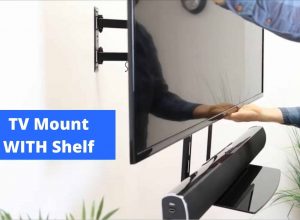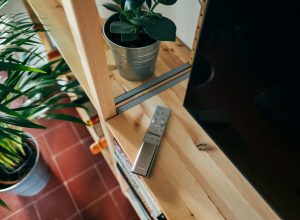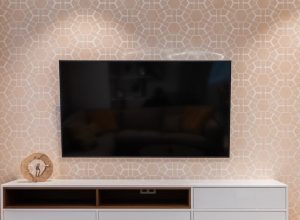In order to keep your cords from showing on the wall-mounted TV, you’ll need to use something to cover them up.
The great news is there are numerous products on the market that help make this easier than ever before! Here’s a look at some of the more popular options available.
Below are some useful tips and tricks on how to choose and use wall mount products effectively and use them to organize your TV cords.
Quick Summary
In this blog, we will discuss some useful things:
- Which products are available in the market to use for cord organization?
- Tips on how to cover cords of a mounted TV.
Hide Your Cords Behind A Wall With The Following Tools

The process of installation is quite simple. At the execution of the day, everything will function as long as you drill two holes in the wall and run some cables down.
However, if you want a safe and clean installation, paying attention to the details is critical.
To Run, a raw power wire behind a wall can cause a fire, but there are ways to reduce the danger. Furthermore, the more time you spend in search of appropriate hole covers, the better your entertainment system will seem.
1. ETL In-Wall Verified Power Cables
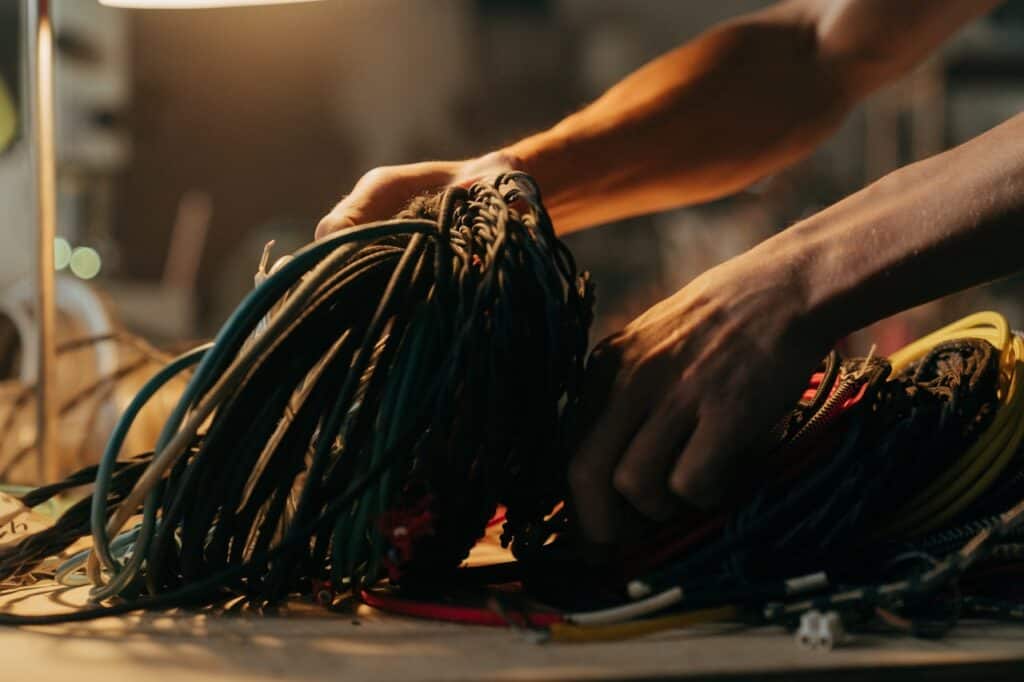
The input jacks on TVs and game devices aren’t up to code. On sites like Amazon, you may easily locate ready-to-use alternatives. They’re designed to work behind a wall and generally come with everything else you’ll need to get started.
2. Typical Wall Hole Plates

Basic wall hole covers will suffice if you do not want to run electrical cords beyond your wall. They hide your wall hole and safeguard your room from anything that may be hidden within your walls.
These plates come in many shapes and colors, and allow you to have your TV cables blend in with the overall aesthetics of your room.
3. Electric Customizable Drill
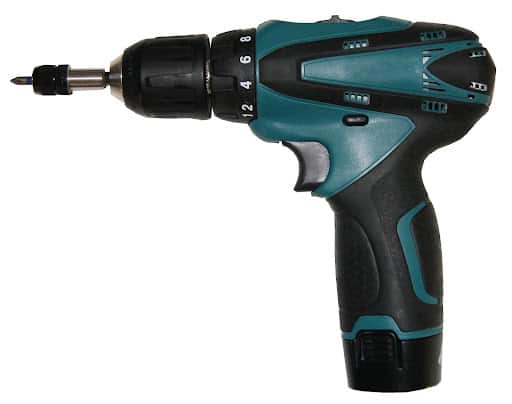
To make a correctly sized hole, you’ll need a particular drill bit piece. As a result, you’ll also need a drill that can accommodate a variety of drill bits.
Keep an eye out for things like this. It has a lot of positive feedback, is inexpensive, and will most likely be sufficient for this modest job.
Additionally, make sure that you find the right places to drill a hole in. Unnecessary holes will not only look very bad but they might also cause damages to your walls.
4. Pvc Hole Saw Bits
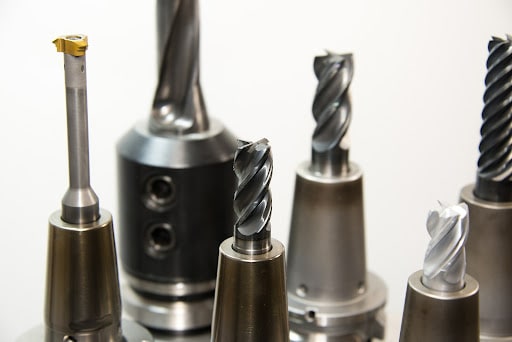
These bits attach to your drill and allow you to drill a properly sized hole in your wall. Double-check that the whole lid and hole cutter is the same dimensions to achieve a satisfactory fit.
5. Cable Lift Push Set
Unless you’re routing your wires straight down, pulling an end out of the receiver hole might be difficult. These kits are designed to let you run wires through the rear end of a concrete wall.
6. Optional Wall Mounts
Wall mounts go a long way in terms of style and organization. These can help you get your Apple TV, PS4, or Xbox Series X closer to your TV or wall hole, making dealing with cords easier.
Steps To Cover Tv Cords by Using Tools
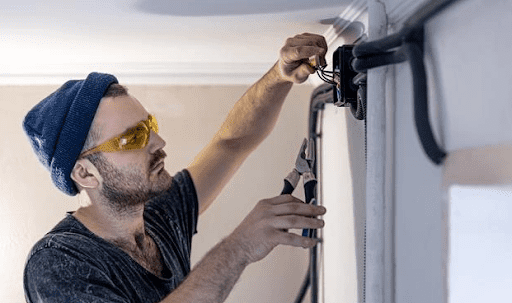
Here we explain step by step in detail the whole working mechanism for using mechanical tools just to cover cords of wall-mounted Tv, so your wall looks clean, and the aesthetics of the room stay vibrant, classy instead of messy.
1. Plan out where you want the holes to go
If your TV is permanently placed on the wall, you’ll need to either remove it or make room for it between the wall and the TV. When the TV is in a common position, your hole should be obscured by the TV.
Three factors will determine the ideal position for your holes: There is a space behind the TV where there are no studs and a nearby outlet while looking beneath that spot.
2. Drill the holes in the second step
You’re ready to drill as long as your chosen site meets the three conditions listed above.
It’s a little complicated if you’ve never connected a drill bit earlier. Watch some tutorial videos to learn about several types of drill bits and how to install rivets in them.
All you have to do now is pull the trigger on your drill while holding it against the wall.
3. Try to find wires
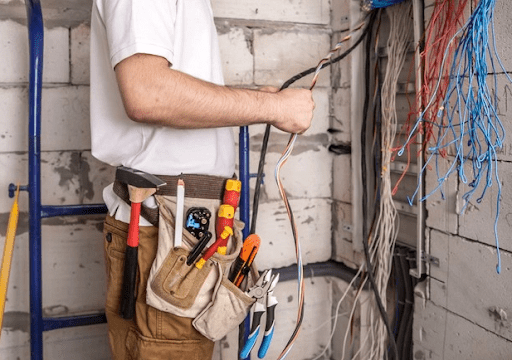
If you bought a kit, please make sure to read the directions carefully because this stage might vary substantially depending on the equipment you have.
These instructions will provide you with a broad notion of how to complete this task.
The power lines and switches that come with the package must be fitted first. They usually have holes where AV cables may be routed once they’ve been installed.
If your above and below ports are parallel to one another, dropping them through the top and grabbing them with your fingertips at the below should be simple.
Pull out your pull push rod and drive them in your way if they are not parallel or in case they become snagged on something within the wall.
Important Things To Keep In Mind before using the drill to make a hole in the wall
Beware of Wires
Amongst the most serious risks of the drill into your walls is hitting a live wire. At best, you’ve broken the circuit and will be without power until it’s repaired; at worst, your error might be fatal.
To repair a damaged wire embedded in the wall is also a difficult process that requires the assistance of a specialist.
Furthermore, they’ll have to open up the wall to get to the damaged wire, which is a costly, dirty, and time-consuming process.
Pipes should be avoided
To drill into a garden hose may not be a fatal error, but it will be expensive.
Due to the type of pipe you strike, you may be subjected to an endless flow of high-pressure water, which causes severe water damage by the time the mains are turned off.
You may also come into contact with a gas pipe, which may be quite deadly if a spark occurs. Pipes are harder to track down than cables since their placement is sometimes unpredictable.
Invest in a Stud Finder
Now, you have just a general concept of where to look for danger, but how sure are you?
A decent stud finder is your best buddy; higher-end devices can identify a wide range of materials, such as wood, metal, and plastic.
They may be used to locate studs to which you wish to screw for a more stable fix, as well as to locate cables and pipelines. Run straight the gadget over the surface; it will beep when there is something behind the wall.
How to Hide TV Wires and TV Cables Without Cutting Into Your Walls?

Sometimes, you might find yourself in a position where it is hard for you to cut or even drill in the walls of your house so wires behind the wall are out of the question.
However, there are still quite a few ways that will allow you to hide TV wires, audio cables, power cables, and get rid of the unsightly wires once and for all, without having to damage your walls.
Here are a few quick ways you can manage all your cables, and the best part is, you can find these solutions at your local hardware store.
Use Zip Ties
One of the easiest ways to manage cables is to make use of zip ties to lock them in place. This simple solution might sound too good to be true, if you have a TV stand in your room or a TV wall mount, you can opt for zip ties and have the TV wires behind the stand.
Just use your zip ties to stop the cables from touching the floor, to avoid any damages to them by moving the stand.
All you need to do is spool up the wires and tuck them behind the stand.
Although you can use a utility knife to cut the zip ties, we suggest giving yourself breathing room in the length of your wires to avoid tugging and pulling when you move the TV stand to access the wires. There are stands with holes to feed your wires through as well.
Just let your cords enter from the top hole and pull them out of the bottom hole. We still suggest using zip ties for such stands as well to avoid tangles.
Invest In A Cable Management Box
Unable to use zip ties for your wires as they are too exposed? Why not use a cable management box? A cable box is a handy tool that allows you to spool up your wires and put them in a plastic box.
They are large enough for quite a bit of wire, along with a surge protector. Additionally, you can also put an extension cord in the box to hide it from view.
These boxes sometimes come with an adhesive backing that allows you to mount them along with the TV mounted on the wall.
When buying a cable management box, make sure to opt for one with an appropriate number of holes and slits in its side for you to get your cables out of the recessed cable plates and into the management box.
This will also allow you to manage your wires more efficiently as you can pull them out of the box in desired directions.
All you would need to do is make sure that you spool and cinch them in a way that the cord covers aren’t damaged and put the lid back up.
Make Use Of A Wall Cord Raceway Kit
If you find it difficult to use a cable box or zip ties with a mounted TV, you can make use of a Wall Cord Raceway kit to lay the path for your cables.
These wall cord concealers are an amazing way of hiding the wires for your TV and other devices without having to cut them into your wall.
With most kits, the raceway base comes with an adhesive backing that allows you to stick it to the wall for optimal management, without any damages to the wall.
Just stick the raceway to the wall, take off the lid of the raceway, rest your wires within the body of it, and put the lid back on.
There are a variety of such products available in the market and you can even opt for one with the same color as your walls to have them mix in with the background. This will allow you to hide the cables and wires in plain sight.
A raceway will also allow you access to the wires and cables whenever you desire, however, with such a product, your wires might need to travel a long distance to get from point A to B.
This is why it is suggested that you replace cables that might be too short, with longer ones.
Use A Baseboard Raceway
If you feel like the power outlet is too far away and the distance between the two cable plates is too much, you might want to make use of a baseboard raceway to provide your wires with a channel to travel across the room.
Although you decided to install the new TV away from the outlets, you still can power it without the wires getting in the way of furniture with the help of this product.
A baseboard raceway is the perfect tool for this as it blends in with your walls, and can even be cut at angles to travel with the walls of your house.
No one will notice them, and your cables will be able to pass through your room without any unwanted attention.
Additionally, most of the raceway will be hidden behind other pieces of furniture, and you will be able to let the wires come out and plug them in.
Use A Fabric Concealer
A fabric concealer is a piece of cloth in the form of a zippered-up sleeve that you can place your TV wires inside.
All you would need to do is wrap the fabric concealer around the wires, and zip it up.
These types of concealers come in handy when your TV is placed in the middle of your room and you cannot make use of raceways to hide them.
Fabric covers come in various colors and allow you to merge them with the aesthetics of your room and let them become a part of it.
This is a great way of hiding cables in a house with pets and you can be sure that no one will be nibbling on the wires and causing damages as well.
Different ways to Cover Cords from A Wall Mount TV
When it comes to covering cords from a wall-mounted TV, there are several effective and aesthetically pleasing options. Here are different ways to achieve a clean and organized look:
- In-Wall Cable Management: This method involves running the cables through the wall itself. It requires some DIY skills and may involve cutting holes in the wall, so it’s best done by someone comfortable with electrical work. Use an in-wall cable management kit or conduit to conceal the wires and ensure they are up to code.
- Cord Covers: Cord covers are available in various designs and materials, such as plastic, fabric, or paintable options. They consist of a channel or raceway that attaches to the wall and covers the cords, providing a neat appearance. Some cord covers can be painted to match the wall color, blending in seamlessly.
- Cable Raceways: Cable raceways are similar to cord covers but offer a larger capacity to accommodate multiple cords. They come in various shapes and sizes, including rectangular, half-round, or corner-mounted options. Cable raceways can be mounted directly onto the wall or hidden behind decorative elements like crown molding.
- Cord Clips: Cord clips are small adhesive clips that can be attached to the wall to hold and route individual cords. They are a simple and affordable solution, ideal for managing a few cables. Cord clips are available in different colors and styles to match your wall or blend in discreetly.
- Powerbridge or Power Outlet Relocation: Powerbridge kits or relocating power outlets can be used to eliminate visible power cords. These kits allow you to install an electrical outlet directly behind the TV, hiding the power cord inside the wall.
- Decorative Conduit or PVC Piping: For an industrial or modern look, you can use decorative conduit or PVC piping to encase the cables. Paint the conduit or piping to match your wall or choose contrasting colors for a more creative touch.
- Wireless Solutions: If possible, consider using wireless technologies like Wi-Fi or Bluetooth to connect your devices to the TV. This eliminates the need for physical cables altogether, reducing clutter and simplifying the setup.
Remember to prioritize safety when dealing with electrical cables. If you’re unsure about any electrical work, consult a professional to ensure proper installation and compliance with local regulations.
How to Cover Cords from A Wall Mount TV - Conclusion
Now that we have reached the end of this guide, it is safe to tell you that if you follow the above-detailed guide properly and with full consciousness, you will succeed in hiding the unnecessary wild wires spread over the TV wall.
We hope this article was helpful. For any further information, feel free to reach out to us.
Adam F.
A/V and Home Theater Expert that focuses on providing clear as well as concise reviews for anything and everything Audio Visual. From TV's, TV Mounts, Soundbars, and Wiring, my focus is to provide expertise in everything Audio Visual focused.



